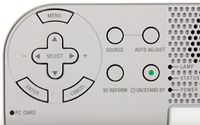NEC HT1000 DLP projector Page 2
 The HT1000 also has two tiny, built-in speakers and 2W of stereo amplification, but these appear to be appendages from the projector's conference-room origins. Ignore them for home-theater use.
The HT1000 also has two tiny, built-in speakers and 2W of stereo amplification, but these appear to be appendages from the projector's conference-room origins. Ignore them for home-theater use.
The remote is a small, unlighted affair that is nevertheless relatively easy to use by feel once you get used to navigating it in the dark. The onscreen menus aren't as ergonomically designed as I'd like. For example, if you do a custom gray-scale (White Balance) setup, then later choose a preset color-temperature setting such as 6500K and click OK, the user White Balance setting will revert to the factory default, deleting your custom setup. Hint: If you do a user calibration, write down and save all settings before exiting the setup menu. Then, if you lose the settings (or if someone else gets into the menu later and messes them up), you can easily restore them and start again. Another possible sticking point: To turn the projector on or off, you have to hold the appropriate button on the remote for several seconds. The first time I pushed it quickly and nothing happened, I thought the projector was defective. Once I'd figured out some of these minor annoyances, however, the remote worked reasonably well.
Setup
Apart from adjusting the HT1000's extensive controls, as discussed above, setting up the projector was no more difficult than with any other DLP projector. Set, aim, zoom, and focus—that's about it.
But for best results, and to minimize picture distortion and the need to use the projector's digital picture-shaping features (which are handy, but best used sparingly), the HT1000 needs to be positioned either slightly below or (for an inverted, ceiling mount) slightly above the screen. A ceiling mount is the better alternative if you combine the projector with a screen such as the Stewart FireHawk. Due to the screen's reflective characteristics, a high-mounted projector will produce a significantly brighter image at a normal viewing height than a table-mount installation. This in turn will let you close the lens's mechanical iris to its minimum setting and get the projector's best contrast ratio. But for review purposes, a ceiling mount was not an option, so I set up the projector on a low table.
All of the HT1000's operating and setup controls—even the White Balance and other color adjustments—are readily accessible in the user menus. This may be video Nirvana for the more technical user, but it can be intimidating to the beginner or technophobe. Unless you have sophisticated measurement and calibration tools, or you have the dealer or a calibration technician tweak your projector, you'll be best off using the factory defaults for Color Correction and the 6500K setting of the Color Temperature control. Of the other features, I had the best luck with the Overscan at "0%," the Gamma on Natural, the Video Filter and Noise Reduction Off, the Black Expansion set to Off or "3," and Contrast Enhancement at "0" or "–1." Use a setup DVD such as Video Essentials for adjusting the conventional video controls: Brightness, Contrast, Color, Tint, and Sharpness.
Because I'd set up the HT1000 on a low table, I got the best results with the projector's iris fully open. I was more than pleased with the resulting blacks, but measurably better contrast is available with a ceiling mount (which increases the amount of light reflected toward the seating position, especially with a screen like the FireHawk) and the iris fully closed. Most of my viewing was through the projector's component inputs. Because I lacked a compatible DVI source, I was unable to try the NEC's DVI input.
Performance
First, the bad news: I saw rainbow artifacts with the NEC HT1000, but they were tolerable. In my experience, only the best of the twice-as-expensive HD2 DLP projectors can do better.
The NEC will not, of course, display full-resolution high-definition images. Hi-def sources downconverted by the HT1000 did look marginally better than the best DVDs, but they didn't pop the way they can through a projector capable of true HD resolution: at least 1280x720. But to get that in a DLP, you'll have to spend at least twice as much money.
The HT1000's 4:3 chip produced a "gray halo" around the picture. This universal problem with 16:9 images from digital projectors using 4:3 chips is simply residual light reflecting from the unused pixels. The NEC doesn't suffer as much from this as projectors with poor blacks, but I still recommend that the wall surrounding your screen be painted black or as dark a shade of gray as possible for at least a foot or two beyond the screen's borders.
I'm now fresh out of negatives—an awkward position for a reviewer! Even though I was constrained to a table-mount setup, the depth of the NEC's blacks was impressive. The image never looked washed-out, even on the darkest scenes. Shadow detail (not the same thing as deep blacks, but related) was not quite CRT-like, but I've tested only one DLP projector that could beat this one for the overall quality of its blacks and still produce a convincingly bright image on the FireHawk screen: the Marantz VP-12S2, which costs more than twice as much as the NEC.
The HT1000's fine blacks and good shadow detail produced convincing images on material that makes many digital projectors scream "Uncle!" The almost continuous low-contrast scenes in Panic Room make it hard to find an appropriate brightness setting on most such projectors; the images tend to look washed-out or blotchy, with crushed blacks and little shadow detail. I'm not going to tell you that the NEC made this movie sparkle, but it did make it look as it should: slightly grungy and grainy but appropriately so, no more and no less.
- Log in or register to post comments





























































